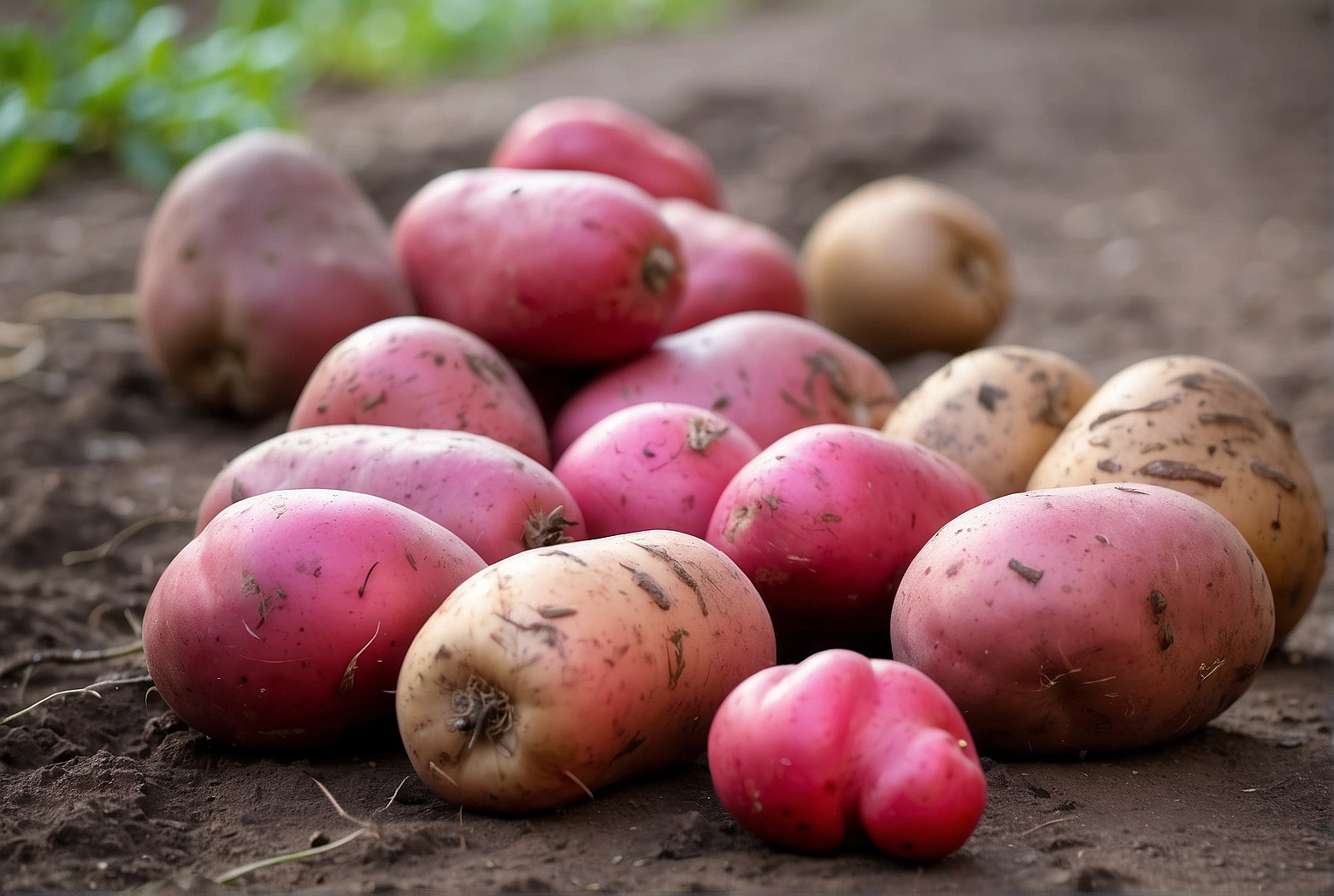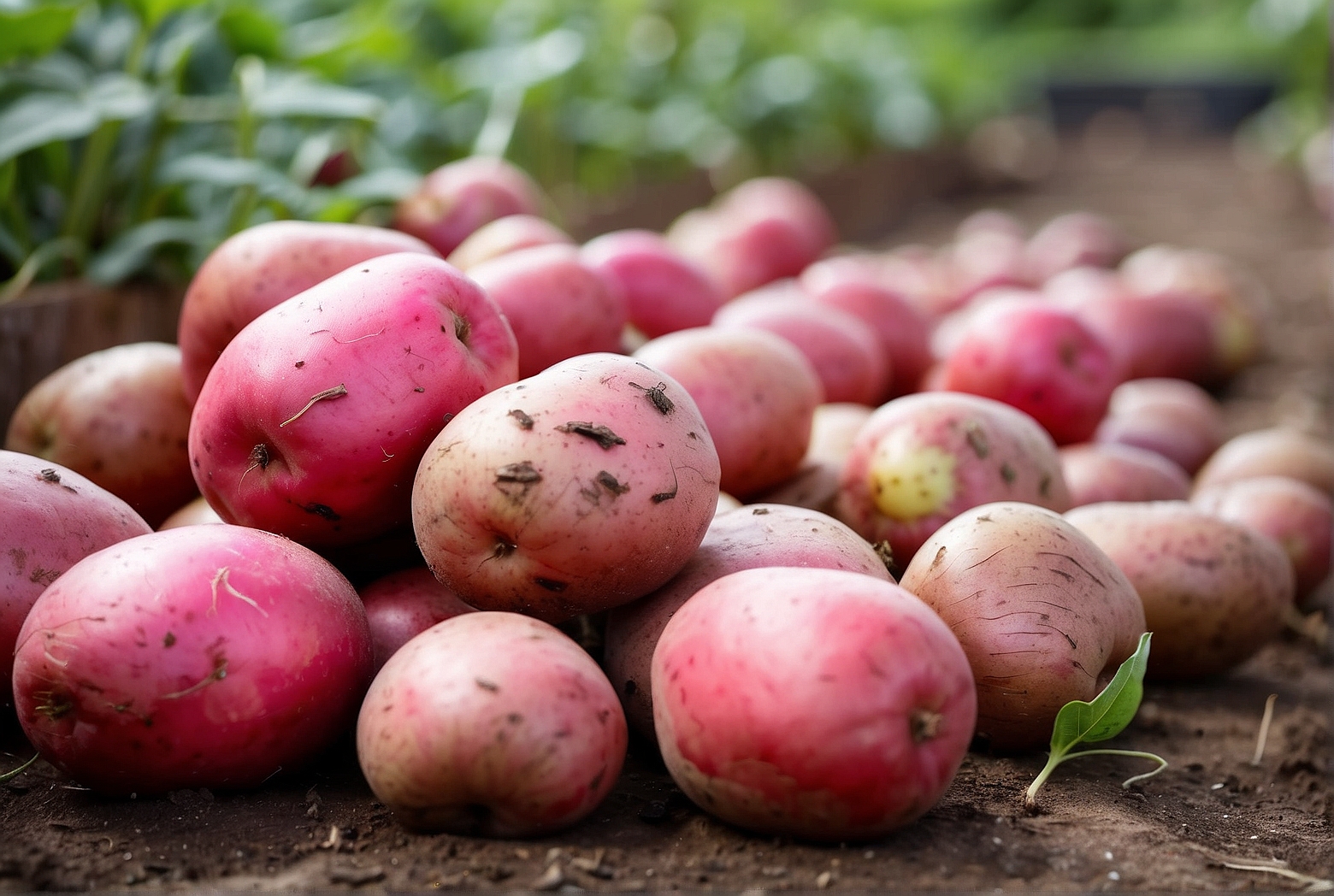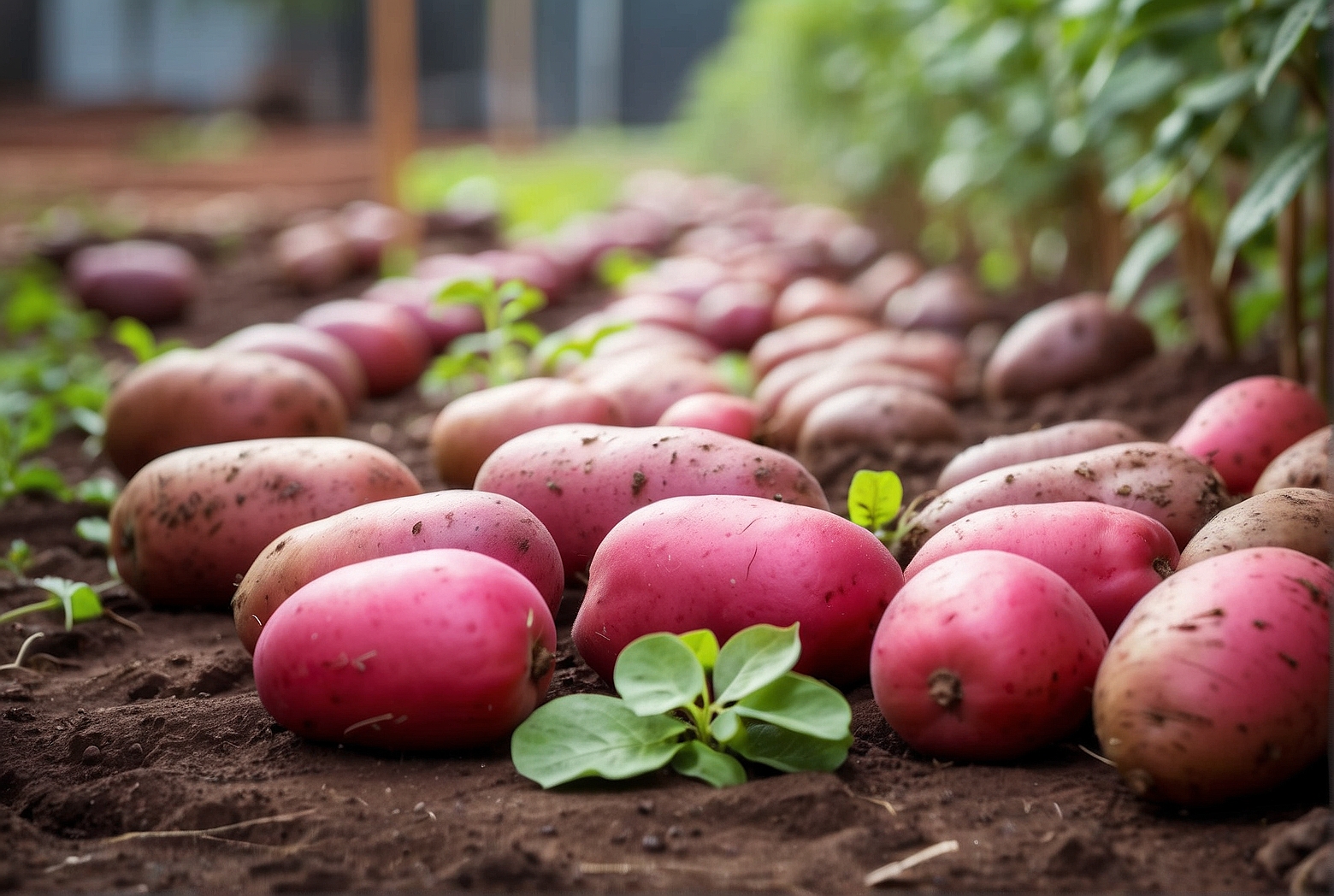Last Updated on April 9, 2024 by Tony Manhart
Are you eager to grow your very own red potatoes but unsure which variety to choose? Look no further! In this article, we will shed light on the key differences between determinate and indeterminate varieties of red potatoes. By understanding these distinctions, you will be able to make an informed decision and embark on a successful potato-growing adventure. So, let’s dig into the fascinating world of red potato cultivation and discover which type is best suited for your gardening desires.
What are Determinate and Indeterminate Varieties?
Definition of determinate varieties
determinate varieties of red La Soda potatoes refer to plants that have a set growth pattern, meaning they grow to a predetermined size and then stop. These plants have a compact structure and tend to be shorter in height. Determinate varieties produce their tubers at the base of the plant, and once the tubers have matured, the plant will wither and die.
Definition of indeterminate varieties
On the other hand, indeterminate varieties of red La Soda potatoes exhibit a continuous growth pattern. These plants can continue to grow and produce new stems, leaves, flowers, and tubers throughout the growing season. Indeterminate potato varieties have a more sprawling growth habit and can reach greater heights compared to determinate varieties. They produce tubers along the length of the underground stems, allowing for ongoing tuber formation as the plant develops.
Growth Characteristics
Plant size and structure of determinate varieties
Determinate varieties of red La Soda potatoes are known for their compact size and structure. These plants typically grow to a specific height, usually ranging from 12 to 24 inches. Their growth is limited, and they tend to form a bush-like appearance. The stems are sturdy and provide ample support for the developing tubers. This growth habit makes determinate varieties suitable for smaller gardens or containers, where space may be limited.

Plant size and structure of indeterminate varieties
Indeterminate varieties of red La Soda potatoes have a more expansive growth pattern compared to their determinate counterparts. These plants can grow much taller, often reaching heights of 30 to 48 inches or more. The stems of indeterminate potato plants tend to spread out, resulting in a more sprawling growth habit. They require more space compared to determinate varieties and are better suited for larger garden areas where they can freely grow and spread.
Growth habit of determinate varieties
Determinate varieties have a predetermined growth habit that results in a bushier appearance. The stems grow laterally, producing leaves and compact clusters of tubers near the base of the plant. As the plants mature, the stems become less vigorous, and tuber development slows down. This limited growth habit allows for an easier harvest, as the majority of the tubers are concentrated in a smaller area.
Growth habit of indeterminate varieties
Indeterminate varieties have a more sprawling growth habit. The stems of these plants continue to grow, producing foliage and tubers along their length as they expand. This growth habit can result in a more extensive underground network of tubers. However, the sprawling nature of indeterminate varieties may make it more challenging to harvest all the tubers and may require careful digging and handling to avoid damaging the crop.
Yield Potential
Productivity of determinate varieties
Determinate varieties of red La Soda potatoes are known for their high productivity. While they may have a limited height and overall growth, these plants are capable of producing a substantial number of tubers within their compact structure. The concentrated tuber development near the base of the plant allows for efficient nutrient allocation and optimal growth conditions.

Productivity of indeterminate varieties
Indeterminate varieties also have excellent yield potential. These plants can produce a significant number of tubers due to their continuous growth and tuber formation along the stems. Although the individual tubers may be smaller compared to determinate varieties, the overall yield can still be substantial. The sprawling growth habit of indeterminate varieties provides more space for tuber development, allowing for a higher total harvest.
Factors affecting yield in both types
Several factors can influence the yield of both determinate and indeterminate varieties of red La Soda potatoes. Adequate sunlight, proper soil moisture, and nutrient availability are essential for encouraging healthy growth and maximizing tuber production. Additionally, proper disease and pest management play a crucial role in ensuring optimal yield. Providing sufficient space and support for indeterminate varieties and harvesting at the appropriate time can also contribute to higher yields.
Harvesting
Timing of harvest for determinate varieties
Determinate varieties of red La Soda potatoes are typically harvested once the plant has reached maturity and the foliage starts to die back. This usually occurs around 70 to 90 days after planting, depending on growing conditions. The dying foliage indicates that the plant has completed its tuber development, and the potatoes are ready for harvest. At this stage, the tubers have achieved their maximum size and are ready to be enjoyed.
Timing of harvest for indeterminate varieties
Harvesting indeterminate varieties of red La Soda potatoes is a bit more challenging since these plants continue to grow and produce tubers throughout the growing season. It is essential to monitor the tubers’ size and maturity regularly. The main harvest can be done once the plant’s foliage starts to die back, similar to determinate varieties. However, small, immature tubers can be harvested earlier for new potatoes, while larger tubers can be left to mature further for full-sized potatoes.
Harvesting techniques for both types
When it comes to harvesting red La Soda potatoes, it is vital to handle the tubers with care to avoid damage and bruising. For both determinate and indeterminate varieties, it is recommended to dig the tubers gently using a garden fork or shovel. Start loosening the soil around the plants, being careful not to pierce or cut the tubers. Once the tubers are exposed, carefully remove them from the soil, making sure to minimize any contact with sharp objects or rough surfaces. Promptly remove any damaged or diseased tubers, and store the remaining ones in a cool, dry place.
Tuber Development
Tuber formation in determinate varieties
Determinate varieties of red La Soda potatoes primarily produce tubers at the base of the plant. As the plant grows and develops, the underground stems, also known as stolons, start producing tubers directly beneath the planted seed potato. The tubers generally form in clusters, creating a consistent size and shape distribution. Determinate varieties tend to have more uniform tubers due to the concentrated tuber development.
Tuber formation in indeterminate varieties
Indeterminate varieties of red La Soda potatoes have a different tuber formation pattern compared to determinate varieties. Instead of tubers forming strictly at the base of the plant, indeterminate varieties develop tubers along the length of the underground stems. This continuous tuber formation allows for varying sizes and shapes of tubers. The tubers may vary in size depending on the distance from the base of the plant, resulting in a more diverse collection of tubers.
Size and shape variation in tubers
Both determinate and indeterminate varieties can exhibit variation in tuber size and shape. However, determinate varieties tend to have more consistent tubers in terms of size and shape due to the concentrated tuber development near the base of the plant. In contrast, indeterminate varieties may have a broader range of tuber sizes and shapes due to the ongoing tuber formation along the stems. This variation can add visual interest and culinary versatility when cooking with red La Soda potatoes.
Disease Resistance
Common diseases affecting determinate varieties
As with any crop, determinate varieties of red La Soda potatoes are susceptible to certain diseases. Some common diseases that can affect determinate potato plants include potato late blight, early blight, potato scab, and common scab. These diseases can impact the overall plant health and reduce tuber quality and quantity. It is important to choose disease-resistant determinate varieties and implement proper cultural and disease management practices to minimize the risk of infection.
Common diseases affecting indeterminate varieties
Similar to determinate varieties, indeterminate varieties of red La Soda potatoes are also susceptible to various diseases. Potato late blight, early blight, potato scab, and common scab can affect indeterminate potato plants, leading to reduced plant vigor and lower tuber quality. It is crucial to select disease-resistant indeterminate varieties and implement appropriate disease prevention measures to protect the crop from infection and ensure healthy tuber development.
Resistant varieties available
To combat the diseases that affect determinate and indeterminate red La Soda potato varieties, there are numerous disease-resistant varieties available in the market. These varieties have been specifically bred to exhibit resistance or tolerance to certain diseases. Some examples of disease-resistant red La Soda potato varieties include ‘Defender,’ which is resistant to late blight, and ‘Atlantic,’ which shows improved resistance to scab. Choosing disease-resistant varieties can significantly contribute to the overall success of potato cultivation.
Growth Management
Supporting determinate plants
Determinate varieties of red La Soda potatoes typically have a compact growth habit, making them less demanding in terms of support. However, providing some support can help maintain the plant’s structure and prevent the stems from bending or breaking under the weight of the developing tubers. Installing stakes or tomato cages around the plants can provide support and contribute to a more organized and visually appealing garden appearance.
Training indeterminate plants
Indeterminate varieties of red La Soda potatoes benefit from appropriate training techniques to manage their sprawling growth habit effectively. As the plants grow, gently guide the stems towards a desired direction to prevent overcrowding and tangling. Additionally, tying the stems to stakes or trellises can help provide support and create a neater and more manageable planting arrangement. Training indeterminate plants enhances airflow, sunlight penetration, and facilitates easier access for harvest and maintenance.
Staking and pruning techniques
Both determinate and indeterminate varieties of red La Soda potatoes can benefit from staking and pruning techniques. For determinate varieties, placing stakes or cages can help support the plants and keep them upright, especially when the tubers develop and add weight to the plant. Pruning off any damaged or diseased foliage can promote air circulation and reduce the risk of disease spread. For indeterminate varieties, staking and regularly trimming excess foliage can aid in managing their sprawling growth and creating a more organized planting layout.
Climate Preference
Adaptability to different climates for determinate varieties
Determinate varieties of red La Soda potatoes are generally known for their adaptability to various climate conditions. They can thrive in both cool and warm climates, making them suitable for a wide range of geographic locations. However, it is important to consider the specific climatic requirements of the potato variety being grown, as some determinate varieties may have preferences for certain temperature ranges. Proper soil preparation, irrigation, and provision of adequate sunlight can further enhance the plant’s adaptation to different climates.
Adaptability to different climates for indeterminate varieties
Indeterminate varieties of red La Soda potatoes also exhibit versatility in terms of climate adaptability. These plants can tolerate a range of temperatures, including both cooler and warmer conditions. However, like determinate varieties, specific climatic preferences may vary depending on the indeterminate potato variety being cultivated. Providing suitable growing conditions, including temperature regulation, sufficient moisture, and appropriate soil preparation, can help indeterminate varieties thrive in diverse climates.
Heat and cold tolerance
When it comes to heat and cold tolerance, both determinate and indeterminate varieties of red La Soda potatoes can exhibit varying degrees of resistance. Some cultivars within each type may have better tolerance to extreme temperatures, while others may be more sensitive. It is essential to select potato varieties that are best suited to the specific climatic conditions of the growing region. Implementing appropriate cultural practices, such as mulching to regulate soil temperature and providing shade during excessively hot periods, can further aid in maintaining plant health and optimizing tuber production.
Storage and Shelf Life
Storage requirements for determinate varieties
Determinate varieties of red La Soda potatoes generally have good storage qualities. To ensure optimal storage conditions, it is crucial to cure the harvested tubers before storing them. Curing involves drying the tubers in a well-ventilated, dark room for a week or two, which helps improve their shelf life and flavor. Once cured, store the tubers in a cool, dry, and dark location. Ideal storage temperatures range between 40 to 50 degrees Fahrenheit (4 to 10 degrees Celsius) with moderate humidity levels.
Storage requirements for indeterminate varieties
Indeterminate varieties of red La Soda potatoes also benefit from proper curing and storage techniques to maintain their quality and prolong shelf life. After harvesting, allow the tubers to cure in a well-ventilated area away from direct sunlight for a week or two. Once cured, store the tubers in a cool, dark place with adequate air circulation. Aim for storage temperatures between 40 to 50 degrees Fahrenheit (4 to 10 degrees Celsius), and maintain moderate humidity levels to prevent excessive moisture loss or tuber rot.
Shelf life comparison
In terms of shelf life, both determinate and indeterminate varieties of red La Soda potatoes can typically be stored for several months if proper storage conditions are maintained. Determinate varieties may have a slightly longer shelf life due to their more uniform tuber development and concentrated tuber formation. However, with appropriate curing and storage techniques, both types of potatoes can retain their taste and quality throughout the storage period.
Uses and Culinary Qualities
Preferred uses for determinate varieties
Determinate varieties of red La Soda potatoes are versatile in the kitchen and can be used in various culinary applications. Due to their smaller size, they are often preferred for boiling, steaming, or incorporating into salads. Determinate varieties generally maintain their shape and texture well when cooked, making them suitable for dishes that require firm potato consistency. Additionally, their rich flavor and creamy texture make them a popular choice for mashed potatoes and gratins.
Preferred uses for indeterminate varieties
Indeterminate varieties of red La Soda potatoes also offer a range of culinary possibilities. The larger size of these potatoes makes them well-suited for baking, roasting, or frying. They can withstand higher cooking temperatures and develop a crispy exterior while maintaining a fluffy interior. Indeterminate varieties are often sought after for making French fries, potato wedges, or hearty potato dishes that benefit from a more substantial potato presence.
Texture, flavor, and cooking characteristics
Both determinate and indeterminate varieties of red La Soda potatoes share similar texture, flavor, and cooking characteristics. Their flesh is typically creamy and moist, providing a pleasant mouthfeel when cooked. The flavor is rich and earthy, adding depth to various dishes. When cooked, both types of potatoes exhibit excellent versatility, maintaining their shape without turning mealy. This makes them suitable for a wide range of cooking methods, ensuring satisfying results in various recipes.
Tony Manhart is a passionate gardener who has been tending to gardens for over 20 years. He takes pride in creating beautiful outdoor spaces with plants, trees, and shrubs that can thrive in any environment. He loves to share his knowledge with others and has taught classes on gardening basics and advanced techniques. He is committed to sustainability, using natural and organic methods to create and maintain gardens. He also works with local organizations to create green spaces for communities. When he’s not gardening, Tony enjoys hiking, reading, and spending time with his family.


